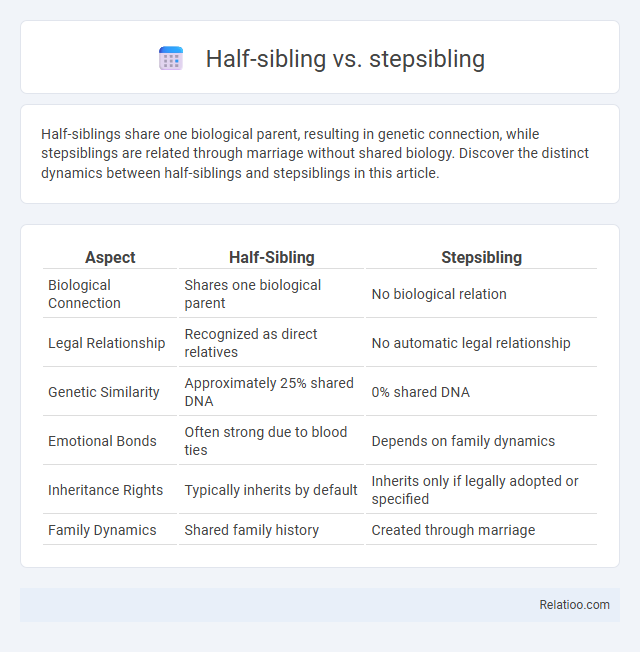Half-siblings share one biological parent, resulting in genetic connection, while stepsiblings are related through marriage without shared biology. Discover the distinct dynamics between half-siblings and stepsiblings in this article.
Table of Comparison
| Aspect | Half-Sibling | Stepsibling |
|---|---|---|
| Biological Connection | Shares one biological parent | No biological relation |
| Legal Relationship | Recognized as direct relatives | No automatic legal relationship |
| Genetic Similarity | Approximately 25% shared DNA | 0% shared DNA |
| Emotional Bonds | Often strong due to blood ties | Depends on family dynamics |
| Inheritance Rights | Typically inherits by default | Inherits only if legally adopted or specified |
| Family Dynamics | Shared family history | Created through marriage |
Understanding Family Relationships: Half-Sibling vs Stepsibling
Half-siblings share one biological parent, creating a genetic connection that influences family dynamics and inheritance rights. Stepsiblings are related through marriage only, without shared biology, often shaping family bonds solely through social and emotional interactions. Recognizing these distinctions is crucial for understanding legal responsibilities, emotional ties, and the complexity of blended family roles.
Defining Half-Siblings: Biological Connections
Half-siblings share one biological parent, either mother or father, which creates a genetic link that distinguishes them from stepsiblings who have no blood relation. Your family role with half-siblings often involves shared heritage and medical history, influencing legal and social dynamics differently from stepsibling connections. Understanding these biological ties helps clarify inheritance rights, genetic counseling, and family bonding responsibilities within blended families.
What Is a Stepsibling? Blended Family Dynamics
A stepsibling is a child related through the marriage of their parents, without shared biological parents, forming part of a blended family dynamic. Stepsiblings often navigate unique emotional and social challenges as they integrate into new family structures distinct from half-siblings, who share one biological parent. Understanding the roles and relationships in blended families is crucial for fostering harmony and supporting the evolving family identity.
Key Differences Between Half-Siblings and Stepsiblings
Half-siblings share one biological parent, resulting in a genetic connection and potential inheritance rights, whereas stepsiblings have no biological relation and are connected only through the marriage of their respective parents. Family roles often assign half-siblings closer kinship status due to shared genetics, while stepsiblings are recognized more as social family members. Understanding these distinctions is crucial for legal matters, inheritance, and defining familial responsibilities within blended families.
Family Structures: Marriage, Divorce, and Remarriage
Half-siblings share one biological parent, impacting inheritance rights and family dynamics differently than stepsiblings, who are related through the marriage of their respective parents without shared genetics. Family structures often evolve through marriage, divorce, and remarriage, creating blended families that redefine traditional sibling roles and legal responsibilities. Understanding these distinctions is crucial for navigating custody arrangements, emotional bonds, and familial support systems in contemporary family law.
Emotional Bonds: Navigating Sibling Relationships
Emotional bonds between half-siblings, stepsiblings, and other family roles vary significantly due to differing biological connections and shared experiences. Half-siblings often share a genetic link that can influence deep-rooted emotional ties, while stepsiblings may develop strong bonds through time spent together and mutual support within blended families. Your ability to navigate these relationships depends on communication, empathy, and the recognition of each unique family dynamic to foster trust and closeness.
Legal and Inheritance Considerations
Half-siblings share one biological parent and often have recognized legal rights to inheritance under intestate succession laws, whereas stepsiblings have no blood relation and generally lack automatic inheritance rights unless explicitly included in wills or legal agreements. Your family role with half-siblings is legally significant in matters of estate distribution, while stepsibling relationships require formal legal documents to establish any inheritance claims. Understanding these distinctions is crucial for estate planning to ensure that your intentions for asset distribution are honored within your family structure.
Challenges in Blended Families
Blended families often face challenges related to the distinct roles of half-siblings and stepsiblings, where half-siblings share biological parents but stepsiblings do not, leading to varying degrees of emotional bonding and identity formation. Navigating loyalty conflicts and establishing clear family roles can create tension among siblings and parents, complicating communication and relationship dynamics. Successfully addressing these challenges requires intentional efforts in fostering trust, defining boundaries, and promoting inclusivity to create stable and supportive family environments.
Supporting Children Through Family Transitions
Navigating family transitions can be challenging when half-siblings and stepsiblings have distinct roles in a child's life, each influencing emotional support differently. Half-siblings share biological ties that often create a natural bond, while stepsiblings form relationships through marriage, requiring intentional efforts to build trust and connection. Your support can foster positive interactions by encouraging open communication and understanding of these unique family dynamics.
Building Strong Relationships in Diverse Families
Building strong relationships in diverse families requires understanding the unique dynamics between half-siblings, stepsiblings, and traditional family roles. Half-siblings share a biological parent, often leading to inherent bonds, while stepsiblings may form connections through shared experiences rather than genetics. You can foster trust and closeness by promoting open communication, respect, and shared activities tailored to each family member's role and emotional needs.

Infographic: Half-Sibling vs Stepsibling
 relatioo.com
relatioo.com